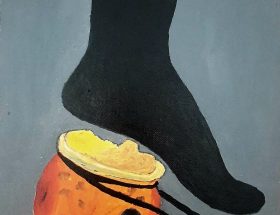Umar Nizar
 Snuff films: murder on camera for commercial gain. The world’s first conference devoted to the mythology of snuff took place at the University of Bournemouth on a weekend in November 2012, a clear indication of how attitudes have changed in the last two decades: the organizers and a number of the delegates had arrived in academia on the back of fan interests.
Snuff films: murder on camera for commercial gain. The world’s first conference devoted to the mythology of snuff took place at the University of Bournemouth on a weekend in November 2012, a clear indication of how attitudes have changed in the last two decades: the organizers and a number of the delegates had arrived in academia on the back of fan interests.
-Kerekes, David. ‘A Culture of Change’
Attitudes change. 2017 was a particularly bad year for Bollywood, by the admission of some of its own leading lights. When the first day collection of a movie came to just around five lakh rupees, the alleged reaction of filmmaker Karan Johar was, ‘how is that even possible?’ as he himself told the audience at Goa’s International Film Festival of India in November, 2017.
2017, a lackluster year for Bollywood also saw the rise of regressive quasi-puranic movies like ‘Rudramadevi’ and ‘Bahubali 2 – the Conclusion’. The mainstream Telugu film industry vies to be the most patriarchal in India (which is saying something), where an accomplished actress like Padmapriya can be slapped by a male filmmaker, and with impunity.
In the guise of moral edification, quasi-puranic movies have demonized indigenous and nomadic peoples. Lyricist and dialogue writer Madhan Karky literally invented a new ‘demon’ language ‘Kilikili’ for the Kalakeyas in the movie ‘Bahuballi’. The profusion of the letter ‘k’ belies the new idiom that these films try to articulate about a no holds barred racist India that is not even apologetic, but rather resolute, with every bit of its ‘touchable’ pride, about flinching away from stark reality of socio-economic disparities. The only real issue is that of H1-B visas.
The sattvik thrills of Puranic entertainment was supplemented in 2017 by the rise of the snuff movie. Each and every mob lynching was recorded by the perpetrators, confident in their righteousness and of their impunity. The logic was that greater the viral-circulation of the lynch-video, greater the humiliation of the victim. And videos did go viral-of a man being set on fire, a girl being abducted from a mud house, railway employees transporting cows getting beaten up till their eyeballs literally popped out of their sockets, of a turbaned man hit on the head with a hammer during a performance, of lovers in various desolate parks getting thrashed till they go went on their knees begging for ‘forgiveness’. All of them were watched millions of times, alone or in company, and often with glee, or anger, or pain and sorrow, amidst tears or laughter, and carefully stashed away in the archive of karma, to be retrieved at some later point and to be savored with pleasure. The scatological movie has meanwhile gone mainstream, in ‘Toilet-Ek Prem Katha’ but crucially without the humour that makes them palatable otherwise.
Like Ziauddin Sardar who says about the Islamic whipping of the adulterous after the implementation of the Hudood ordinance in Pakistan, that though he was revolted by the idea of it, he always had wanted to witness one, so does the snuff movie interpellate everyone into its sphere of violent spectatorship. Everyone wants to see it, at least indirectly, for indignation’s sake.
Whether one’s response is “when will I see it?” or “what have I just seen?,” viewing snuff is characterized by a looking forward that constantly evokes a looking back. The appropriate grammatical tense for snuff ‘s temporal tension, then, is the future perfect, or the present expectation of a future in which “I will have seen” something whose shocking, titillating, disgusting or disturbing impact may, in retrospect, turn out to have been transformative. This shock that I anticipate having already experienced means that the compelling persistence of the snuff film, its refusal to fade away despite lack of any evidence for its actual existence, must be addressed in terms of the temporal cadences of its affective reality rather than simply its evidentiary basis. The mythology of snuff thus stretches beyond catalogs of disturbing realism to its promise of affective entry into a backward-looking future of the viewing subject: what will I be once I become the person who has seen “it”?
-Kavka, Misha. ‘The Affective Reality of Snuff’
In India, the future perfect tense of ‘I will have seen’ is commingled with the future anterior, ‘in order to have been,’ where, you posit a glorious Aryan pastoralist past for yourself. Since you have given up on the future, attempts at changing the past have become the dominant narrative. The snuff movie has a dark history going all the way back to the Nazi-era Holocaust.
India doesn’t have a national cinema, and hence nationalism and the national anthem waft alongside cheesy popcorn aromas in cinema halls. The rise of the cow-snuff video makes up for such lacunae since the time when Phalke made a mythical movie about an honest king-‘Raja Harishchandra’. Cow-snuff movies reflect the logic of a new digital India, where formalization of the economy and muscular monetary discipline go alongside the slow demise of modern carceral discipline which has lost its way into the dreary desert sands of puranic anarchy. The caste-human with every bit of his ‘touchable pride’ gradually comes to replace that other great invention of Western enlightenment-the rational human. The carceral regime has been replaced by a different regime of visibility. What porn did for gender, snuff is supposed to do for race. And from Rodney King to Mohammed Afrazul, witness videos have altered in nature.
Rusche and Kirchheimer relate the different systems of punishment with the systems of production within which they operate: thus, in a slave economy, punitive mechanisms serve to provide an additional labour force — and to constitute a body of ‘civil’ slaves in addition to those provided by war or trading; with feudalism, at a time when money and production were still at an early stage of development, we find a sudden increase in corporal punishments — the body being in most cases the only property accessible; the penitentiary (the Hopital General, the Spinhuis or the Rasphuis), forced labour and the prison factory appear with the development of the mercantile economy. But the industrial system requires a free market in labour and, in the nineteenth century, the role of forced labour in the mechanisms of punishment diminishes accordingly and ‘corrective’ detention takes its place.
― Michel Foucault, Discipline and Punish: The Birth of the Prison
The snuff filmmaker, with the phallic camera, is the new hero. He/she (sometimes just a child told to hold a camera) is an icon in the pantheon alongside Savarkar.
Neil Jackson outlines the emergence of the snuff filmmaker as a key icon within American realist horror texts of the 1970s and 1980s. Set apart from the now common motif of sex murderer/serial killer who ritually shoots murder as part of their activities, Jackson argues that the representation of the snuff “auteur” allows for a reflexive interrogation of the extremes (and limitations) of the phallocentric tendencies of the horror film.
-Jackson, Neil. ‘Shot, Cut and Slaughtered’
We are all fans of the snuff movie. We have all taken the snuff. We are all waiting for the sneeze.
~~~
Umar Nizar is a Research Scholar in JNU. His poems have been published in the Ibex Press Year’s Best Selection, Vayavya, MuseIndia, Culture Cafe journal of the British Library, and also broadcast by the All India Radio. He has previously worked with the New Indian Express as a Reporter.









